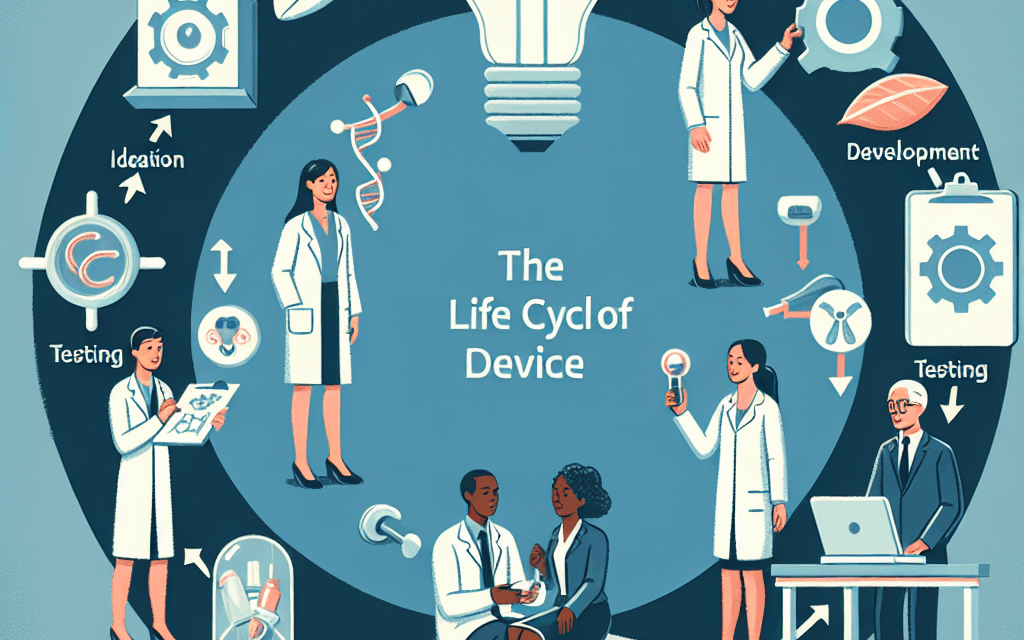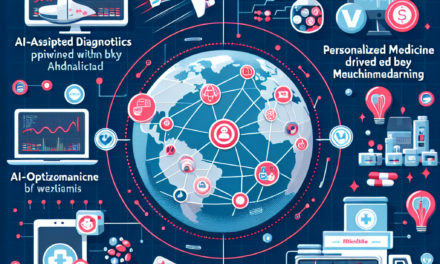Navigating the Journey: The Lifecycle of a Medical Device from Idea to Regulation
The medical device industry is a complex and dynamic field that plays a crucial role in healthcare. From conception to market entry, the lifecycle of a medical device involves multiple stages, each with its own set of challenges and regulatory requirements. This article will explore the journey of a medical device from the initial idea to regulatory approval, highlighting key phases, challenges, and best practices along the way.
1. Ideation and Concept Development
The journey of a medical device begins with ideation, where innovative ideas are generated to address unmet medical needs. This phase is critical as it sets the foundation for the entire project.
Identifying Unmet Needs
Successful medical devices often stem from a clear understanding of the problems they aim to solve. Identifying unmet needs involves:
- Conducting market research to understand existing solutions and their limitations.
- Engaging with healthcare professionals to gather insights on patient care challenges.
- Analyzing patient feedback and outcomes to identify areas for improvement.
For example, the development of continuous glucose monitors (CGMs) was driven by the need for better diabetes management tools. Traditional fingerstick blood glucose testing was painful and inconvenient, prompting innovators to create devices that provide real-time glucose readings.
Brainstorming and Conceptualization
Once a need is identified, brainstorming sessions can help generate potential solutions. This phase often involves:
- Collaborating with multidisciplinary teams, including engineers, clinicians, and designers.
- Utilizing design thinking methodologies to foster creativity and innovation.
- Creating initial sketches and prototypes to visualize concepts.
For instance, the concept of a wearable heart monitor emerged from brainstorming sessions that highlighted the need for continuous cardiac monitoring outside of clinical settings. This led to the development of devices that could track heart rhythms in real-time, providing valuable data for both patients and healthcare providers.
Feasibility Assessment
Before moving forward, it is essential to assess the feasibility of the proposed concept. This includes:
- Evaluating technical feasibility by analyzing the required technology and resources.
- Conducting preliminary market analysis to estimate potential demand and competition.
- Estimating costs and potential return on investment (ROI).
A case study in this phase is the development of robotic surgical systems. Initial feasibility studies revealed significant technical challenges, but the potential for improved surgical outcomes justified further investment and development.
2. Design and Development
Once a concept is validated, the next phase is design and development, where the idea is transformed into a tangible product. This phase is crucial for ensuring that the device meets both user needs and regulatory requirements.
Design Control and Documentation
Design control is a systematic approach to managing the design process. Key elements include:
- Establishing design inputs based on user needs and regulatory requirements.
- Creating design outputs, including specifications, drawings, and prototypes.
- Implementing design reviews to assess progress and make necessary adjustments.
Documentation is vital throughout this process. For example, the FDA requires comprehensive documentation to demonstrate that a device meets safety and efficacy standards. Companies must maintain detailed records of design changes, testing results, and risk assessments.
Prototyping and Testing
Prototyping is an essential step in the development of a medical device. It allows for:
- Testing the functionality and usability of the device.
- Gathering feedback from potential users and stakeholders.
- Identifying design flaws and areas for improvement.
For instance, the development of an orthopedic implant may involve creating multiple prototypes to test different materials and designs. Each iteration provides valuable insights that inform the final product.
Risk Management
Risk management is a critical component of the design and development phase. It involves:
- Identifying potential hazards associated with the device.
- Assessing the risks and implementing mitigation strategies.
- Documenting the risk management process to comply with regulatory standards.
The ISO 14971 standard provides a framework for risk management in medical devices. Companies must demonstrate that they have identified and addressed potential risks to ensure patient safety.
3. Preclinical and Clinical Testing
Before a medical device can be marketed, it must undergo rigorous testing to ensure its safety and effectiveness. This phase typically includes preclinical and clinical studies.
Preclinical Testing
Preclinical testing involves laboratory and animal studies to evaluate the device’s performance and safety. Key aspects include:
- Conducting bench tests to assess the device’s functionality.
- Performing biocompatibility testing to evaluate the device’s interaction with biological tissues.
- Using animal models to study the device’s effects in a living organism.
For example, a new drug delivery system may undergo preclinical testing to assess its ability to release medication at the desired rate and location within the body. These studies provide critical data that inform the design of clinical trials.
Clinical Trials
Clinical trials are essential for evaluating the safety and efficacy of a medical device in human subjects. This phase typically involves:
- Designing a clinical trial protocol that outlines objectives, methods, and endpoints.
- Recruiting participants and obtaining informed consent.
- Collecting and analyzing data to assess the device’s performance.
Clinical trials are often conducted in phases, starting with small pilot studies and progressing to larger, randomized controlled trials. For instance, the development of a new stent may involve multiple phases of clinical trials to demonstrate its safety and effectiveness compared to existing options.
Regulatory Considerations in Testing
Throughout the testing phase, it is essential to adhere to regulatory requirements. This includes:
- Submitting an Investigational Device Exemption (IDE) application to the FDA for clinical trials.
- Complying with Good Clinical Practice (GCP) guidelines to ensure ethical conduct.
- Maintaining detailed records of all testing activities and results.
Failure to comply with regulatory requirements can result in delays or rejection of the device’s approval. Therefore, it is crucial to work closely with regulatory experts throughout the testing process.
4. Regulatory Approval and Market Entry
Once testing is complete, the next step is to navigate the regulatory approval process. This phase is critical for ensuring that the device can be legally marketed and sold.
Understanding Regulatory Pathways
Different regulatory pathways exist for medical devices, depending on their classification and intended use. Key pathways include:
- Premarket Notification (510(k)): For devices that are substantially equivalent to existing products.
- Premarket Approval (PMA): For high-risk devices that require extensive clinical data.
- De Novo Classification: For novel devices that do not have a predicate.
For example, the 510(k) pathway is commonly used for devices like surgical instruments, where manufacturers can demonstrate that their product is similar to an already approved device. In contrast, a new type of implantable device may require a PMA due to its higher risk profile.
Preparing Regulatory Submissions
Preparing regulatory submissions is a complex process that requires careful attention to detail. Key components include:
- Compiling data from preclinical and clinical studies to support safety and efficacy claims.
- Providing detailed descriptions of the device’s design, manufacturing processes, and labeling.
- Addressing any specific questions or concerns raised by regulatory agencies.
For instance, when submitting a 510(k) application, manufacturers must provide evidence of substantial equivalence, including comparative data and performance testing results. This documentation is critical for gaining approval.
Post-Market Surveillance and Compliance
After receiving regulatory approval, manufacturers must continue to monitor the device’s performance in the market. This includes:
- Implementing post-market surveillance systems to track adverse events and device performance.
- Conducting periodic safety updates and reporting to regulatory agencies.
- Addressing any issues that arise and implementing corrective actions as needed.
For example, the recall of certain hip implants due to high failure rates highlights the importance of post-market surveillance. Manufacturers must be proactive in monitoring their devices to ensure ongoing safety and effectiveness.
5. Commercialization and Market Strategy
The final phase of the medical device lifecycle involves commercialization and market strategy. This phase is crucial for ensuring the device reaches its intended audience and achieves commercial success.
Developing a Marketing Strategy
A well-defined marketing strategy is essential for promoting the device and driving sales. Key elements include:
- Identifying target markets and customer segments.
- Developing messaging that highlights the device’s unique value proposition.
- Creating promotional materials and campaigns to raise awareness.
For instance, the launch of a new telehealth platform may involve targeted marketing campaigns aimed at healthcare providers and patients, emphasizing the convenience and accessibility of remote care.
Sales and Distribution Channels
Establishing effective sales and distribution channels is critical for reaching customers. This includes:
- Identifying potential distribution partners, such as medical supply companies or wholesalers.
- Training sales representatives on the device’s features and benefits.
- Implementing a robust supply chain to ensure timely delivery of products.
A case study in this area is the commercialization of a new orthopedic device, which may involve partnerships with hospitals and clinics to facilitate adoption and integration into surgical practices.
Monitoring Market Performance
Once the device is on the market, it is essential to monitor its performance and gather feedback from users. This includes:
- Tracking sales data and market share to assess commercial success.
- Collecting user feedback to identify areas for improvement.
- Adjusting marketing strategies based on market trends and competitive landscape.
For example, a company may analyze sales data to determine which regions are performing well and which may require additional marketing efforts. This data-driven approach allows for continuous improvement and adaptation in a competitive market.
Conclusion
The lifecycle of a medical device from idea to regulation is a multifaceted journey that requires careful planning, collaboration, and adherence to regulatory standards. Each phase, from ideation to commercialization, presents unique challenges and opportunities for innovation. By understanding the complexities of this process, stakeholders can navigate the medical device landscape more effectively, ultimately leading to improved patient outcomes and advancements in healthcare.
Key takeaways from this article include:
- The importance of identifying unmet needs and conducting thorough market research during the ideation phase.
- The necessity of rigorous design control and documentation to ensure compliance with regulatory requirements.
- The critical role of preclinical and clinical testing in demonstrating safety and efficacy.
- The complexities of navigating regulatory pathways and preparing submissions for approval.
- The significance of developing a robust marketing strategy and monitoring market performance post-launch.
As the medical device industry continues to evolve, staying informed about best practices and regulatory changes will be essential for success in this dynamic field.





